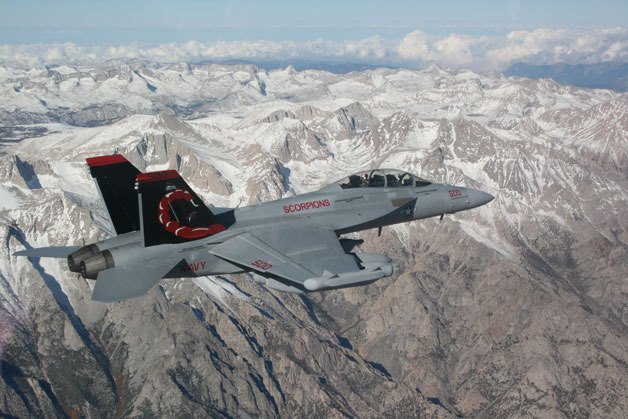Another group is taking aim at Whidbey Island Naval Air Station’s jets.
Members of Protect Olympic Peninsula delivered a petition with more than 120,000 signatures to the United States Forest Service protesting the Navy’s plan to introduce electromagnetic transmitters to its electronic warfare training on the peninsula.
The group joined with other activists, including Citizens of Ebey’s Reserve, which would like to shut down EA-18G Growler flight training at the outlying field at Coupeville.
THE PETITION states: “Unfortunately, if the Navy gets their way, these wilderness areas will be assaulted by 118 of the world’s loudest jets, flying thousands of training exercises, hundreds of days a year, as low as 1,200 feet above the ground.”
The petition goes on to describe the peace and tranquility of Olympic National Park and urges people to take action “to keep the Navy from destroying this wonderful area with their ear-splitting jets.”
“In addition, the Navy will be using these war games to test electromagnetic weaponry, which has some experts raising concerns about potential health impacts to birds, amphibians and humans, as well.”
Forest Service officials accepted a printout listing signatures and listened to concerns, said Linda Sutton of Port Townsend, who attended the meeting.
“It sounded like they were not able to say ‘No’ to the military easily,” she said.
“We think it would be good for the Forest Service to stand up and say ‘No.’”
NAVY OFFICIALS said the petition isn’t based in fact and only serves to spread misconceptions.
The petition implies that flying jets over the peninsula is something new, and that the Forest Service could prevent jets from flying over the area.
Neither is true, according to the Navy.
The Navy already flies jets and conducts electronic warfare training over the Olympic Peninsula — and has done so for more than 40 years, said NAS Whidbey spokesman Mike Welding.
The Navy is asking the Forest Service for a special-use permit to drive three trucks equipped with electromagnetic transmitters on their roads as well as to add one fixed emitter site at Naval Station Everett annex at Pacific Beach.
The plan doesn’t change where aircraft fly or at what altitude, and the Navy said it shouldn’t be any noisier than it is now.
THE NAVY’S plan does include more flights — about a 10 percent bump. The average number of flights in the past two years was about 1,250 a year.
The trucks would be equipped with electromagnetic transmitters that use frequencies similar to those used by Wi-fi devices, cordless phones and weather radar systems. They aren’t any more powerful — or dangerous — than the output of a television news van or marine radar used on boats, he said.
“There is no danger to humans, wildlife or fauna from the proposed electronic warfare activities,” he said. “Any statement to the contrary is simply not based on fact.”
THE NAVY contends the mobile emitters provide more realistic training for pilots and would save fuel, travel and maintenance costs — about $4.6 million a year. Now, pilots use simulations inside the cockpit or they fly to Mountain Home Air Force Base in Idaho to use emitters there.
“Transmitters are used to send a signal, similar to what might be encountered by potential adversaries to the aircraft, for the aircrew to process, identify and locate,” Welding said.
“The electronic warfare range training does not involve the use of weapons.”
He added that the training is critical to prepare Navy aircrew for the challenges they encounter in the line of duty.
“We owe them our support as they sacrifice to protect our freedoms and way of life,” he said.
THE PERSON who started the petition is Aaron Viles, a professional grassroots organizer who lives in New Orleans. The petition is through Care2, a company that asks its worldwide network of followers to sign multiple petitions on a variety of issues, including ending dolphin captivity and telling Ellen Degeneres to remove leather from her clothing line.
This particular petition is listed with others under a heading for “sign the hottest petition.”
The website encourages people to sign with this: “Urgent: Don’t turn the Olympic Peninsula into a war zone! Block the Navy jets!”
While some people who signed the petition are from the Northwest, most live in places as far flung as Australia, France and Belgium.
PROTECT OLYMPIC Peninsula, the group that delivered the petition, was formed last year after someone in the town of Forks spotted a notice about the Navy’s petition posted at the local post office. They asked the local newspaper to look into the matter.
People in the area felt blindsided and didn’t feel they had enough time to comment, Sutton said.
“Most people felt it was a deception that was pushed through,” she said.
The environmental assessment the Navy completed doesn’t address issues such as the potential loss of tourism dollars caused by the Navy’s operations or the potential of fire danger if a plane crashes, she said.
SUTTON SAID nearly 65,000 signatures were from the U.S. and of those nearly 8,000 were from Washington state.
Sutton said no one from her organization wrote the language in the petition and they aren’t responsible if people elsewhere misunderstand the Navy’s proposal.
“It’s not something we wrote,” she said. “We just delivered it.”
The Forest Service is still sifting through more than 3,000 comments about the proposal, and a decision is not expected until next year, said Glen Sachet, a spokesman with the Forest Service.



